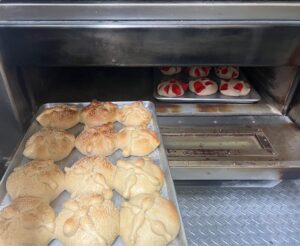During the last days of October, preparations start for Día de los Muertos, an indigenous festivity celebrated every year on Nov. 1 and 2. All around the world, including the South Bronx, the Mexican community carries out this beloved tradition.
Inside Mott Haven Mexican grocery stores “Don Jose” and “Santa Cruz,” the tradition is kept alive and strong by their owners, former seamstress-turned-baker Maria Bravo, as well as her husband and son.
All year long, Bravo arrives at 216 St Ann’s Ave. at 9:30 am to begin her day of baking a countless amount of fresh pan dulce (traditional Mexican sweet bread). She brings pan dulce to life by mixing flour, sugar, salt, vegetable shortening, pork lard, yeast, and water.
To make Pan de Muerto, also known as Hojaldras, water is replaced with eggs and milk, making it more costly – a reason it is made only during the season of Día de los Muertos, she explained. Close culinary cousins are Monas, which are baked year-round but are most popular during this season.
This bread is not just for eating. It will be placed on home altars and on gravesites on Día de Los Muertos in remembrance of loved ones – a tradition that originates in pre-Hispanic, indigenous cultures, according to the The National Institute of Indigenous Peoples.
Usually, Bravo, with the help of her employees, finishes the arduous task of baking at around 2 pm. Each batch has to rest between 15 and 30 minutes in a warm environment to ensure it is soft and rises correctly.
The process requires attention to detail and patience. And at the end of each day, dough for the next morning must be made and refrigerated. The next day, while this first batch is baking, more dough is made and given time to rest.
On a regular day, Vanilla and Chocolate Conchas are the customer favorites. But in the days leading up to Día de los Muertos, particularly Oct. 28, Oct. 31 and Nov. 1, demand spikes for Monas and Hojaldras.

Demand is so high, especially every Oct. 31, that trays full of Pan de Muerto begin filling Bravos’ ovens as early as 6 am and no other type of bread is baked that day, only Monas and Hojaldras.
For over 12 hours, Pan de Muerto keeps going in and out of the ovens.
“No la pasamos aquí haciendo el pan” We spend [the holiday] here, making the bread, Bravo said. It is one of the ways she pays homage to Día de los Muertos. She also sends money back to her mother in Mexico to put up an altar.
For those who wish additional ways to remember the departed, the stores also sell Flor de Cempasuchil, an orange or yellow flower used on many home altars. Bravo grows the flowers herself at her home from seeds her father-in-law sent her from Mexico.
Bravo recommends accompanying las Monas with a cup of fresh-brewed coffee. The Hojaldras, she believes, pairs better with a cup of Mexican hot chocolate.
Baker Jenny Lorenzo, 21, holds the bread dear to her heart, “It has a unique flavor that really lets you feel this tradition.”

